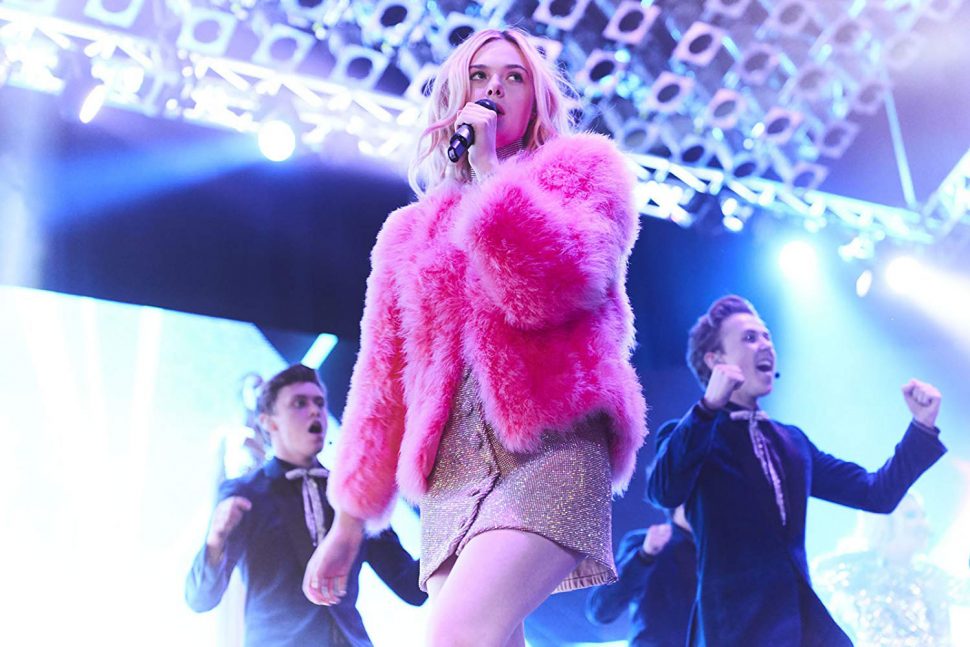 In a mid-year movie season that feels built on familiar tropes (the current slate of films in cinemas affirms this), the recent digital-release “Teen Spirit” probably seems too apt. The film is all about familiar tropes. A poor girl in a remote village moves from taciturn loner to wannabe star as she becomes a major competitor in an American Idol-type competition in the UK. It doesn’t take a genius to guess where this will go and how it will get there. Yet, despite the familiarity of that logline, “Teen Spirit” feels fresh and warm, like a shot of bubble-gum flavoured drink that goes with a kick. It’s as good a sign of the old adage about art that it’s not about the what but the how and, for me, it’s just the right bit of counterprogramming to counteract the more exhausting forays into trope-hopping and recycling that’s been happening in the cinemas for the last few weeks.
In a mid-year movie season that feels built on familiar tropes (the current slate of films in cinemas affirms this), the recent digital-release “Teen Spirit” probably seems too apt. The film is all about familiar tropes. A poor girl in a remote village moves from taciturn loner to wannabe star as she becomes a major competitor in an American Idol-type competition in the UK. It doesn’t take a genius to guess where this will go and how it will get there. Yet, despite the familiarity of that logline, “Teen Spirit” feels fresh and warm, like a shot of bubble-gum flavoured drink that goes with a kick. It’s as good a sign of the old adage about art that it’s not about the what but the how and, for me, it’s just the right bit of counterprogramming to counteract the more exhausting forays into trope-hopping and recycling that’s been happening in the cinemas for the last few weeks.
In a small village in the Isle-of-Wight, Violet Valenski lives with her mother and listens to pop songs on her iPod while she milks the cows. It’s a rustic, simple life, even if a bit colourless. She waits tables at a dingy pub and wards off a grumpy old man that wants to be her manager. Things change when a talent scout comes to the village for auditions for the pop competition, Teen Spirit. Despite the genericity of the name, the film is much more about the specific than the general. Character-study is not the first thing that comes to mind when you watch it, but this is a movie all about the star at its centre. So that it’s not much about teen spirit as it is about Violet’s. And, that’s key to its success.
“Teen Spirit” is the directorial debut of Max Minghella, an actor-turned-director and son of legendary director Anthony Minghella. I felt an undercurrent of trepidation when I first heard of it. How would the younger Minghella’s work hold up when measured against his father’s heavy shadow? But, “Teen Spirit” is so very much its own thing. The charm of “Teen Spirit” is how unabashedly itself it is. There’s nothing coy or disingenuous about it, and it’s well tuned to reflect the sensibilities of its prickly heroine. “Teen Spirit” is a refreshingly unselfconscious debut. Elle Fanning’s performance at the centre of the film is a big part of this.
Fanning’s turn is arguably the film’s most subversive element. Violet, as played by Fanning, is not the kind of girl we see in this kind of story. Her moody teen angst is perhaps familiar at first but becomes intriguing and then surprising when we realise that it’s not teenage posture but just her natural stoicism. She’s just not a sociable person, not because of some great hidden pain. It lends the film’s a compelling clarity, avoiding the expected “revelation” of some dark secret. Violet just loves music and “Teen Spirit” is proud of its musical sensibilities. So, each music sequence becomes devoted to being a performance. In the real world, Violet’s life is bathed in shadows and muted lights but when the music plays, those musical dreams become bathed in neon. The first full musical sequence, set to Robyn’s “Dancing on My Own”, buoyed on by cameras that can’t stop moving, is so vividly realised. Music gives Violet depth. And music gives the film depth.
It’s the care put into the production that makes it hard to write of the thinness of the script as laziness. Minghella knows exactly who this girl is. Her musical choices don’t follow the mainstream balladeering that might make the film more of a pop hit. The playlist feels authentic, individualistic and lived-in. And it’s that realness, amidst all the neon, that makes “Teen Spirit” feel so refreshing. It’s pop-oriented filmmaking that doesn’t confuse pop with being toothless. Instead, here it’s all sharp edges. But fun.
In an ideal world, “Teen Spirit” would have been a sleeper hit. It’s efficiently deployed, it’s lithe, it’s effervescent and it’s very much its own thing, even as it builds on the familiar. It’s somewhat understandable why it’s been written off as a trifle, a sugary bauble. But, some of the dismissiveness feels so puzzling. The film is so smartly aware of its tropes, that it knows just when to avoid them. The final shot, centring on a revelation another film may have dragged out, is so smartly oblique. It’s the rare film thus far of 2019 that feels certain of exactly what it is. Limitations and all. By the time Violet begins to belt out, “Don’t kill my vibe” in the film’s big final musical sequence, it feels as much about the film as her. The neon sheen. The unexpected cutaways. The slyness. The unabashed revelling in the youthfulness of this story. “Teen Spirit” is all hung up on its iridescent musical style. So was I.
Teen Spirit is available to watch on AmazonPrime Video, iTunes and Google Play.






